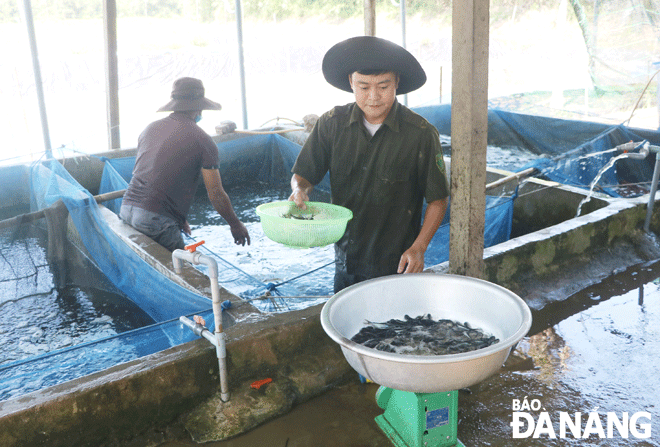Actively source freshwater fingerlings in aquaculture
For the time being, Da Nang’s agricultural sector has actively implemented a wide range of activities to promote exploitation, regenerate fish fingerling sources, and support aquaculture farmers in accordance with local natural conditions; thereby, serving sustainable aquaculture development.
 |
| Officials of Hoa Khuong Agricultural Experimental Hatchery prepare fish seed sources to support farmers. Photo: VAN HOANG |
Support production of fingerlings
In the middle of May, the Da Nang Fisheries Sub-Department has just supported 80,000 traditional freshwater fish seeds for aquaculture households, especially disadvantaged households in Hoa Vang District to increase production and overcome the difficult consequences of natural disasters. Accordingly, the number of fingerlings supported for each household is from 1,000 to 5,000 fish depending on the area of the fish ponds.
As shared by Mr Huynh Duc Trung, Head of Hoa Khuong Agricultural Experimental Hatchery, every year, the unit incubates and reproduces on the spot freshwater aquatic fingerlings such as catfish, red tilapia, and carp to supply to farmers in the city. Although the first quarter of 2022 was not the main fish farming season, the hatchery has provided nearly 200,000 fingerlings of all kinds.
According to the Fisheries Sub-Department under the Department of Agriculture and Rural Development, the total area of freshwater aquaculture in the whole city covers 148,427 hectares, mainly in Hoa Vang District. In the period 2011-2020, the average output from traditional fish farming is 602 tons per year, the yield is 4 tons per hectare. Since 2016, the city's agricultural sector has supported 696,200 freshwater fish fingerlings for 434 aquaculture households in the area to help people increase production.
According to the Director of the Center for Agro-Forestry Extension Dang Van Hong, freshwater aquaculture areas have contributed significantly to the development of the fisheries economy, helping to enhance and improve the quantity as well as the quality of aquatic resources. This contributes to creating a source of valuable agricultural products, meeting local market demand, creating jobs, and increasing income in tandem with stabilizing the life of many local households.
On an annual basis, the Department of Agriculture and Rural Development has deployed numerous activities to strengthen agricultural extension, transfer agricultural science and technology, and replicate effective freshwater aquaculture models. Simultaneously, the work of supporting and taking the initiative in the source of fish seeds and raw materials for the cultivation and development of freshwater fisheries has been also focused on by the sector.
Actively source local fingerlings
Since 2015, Hoa Khuong Agricultural Experimental Hatchery has successfully implemented many freshwater aquaculture projects such as experimenting with artificial reproduction of hybrid catfish, artificial reproduction, and rearing (raised from fry to develop into fingerlings) of red tilapia and carp, actively creating fish seed sources for local farmers.
Mr Huynh Duc Trung said that when the problem of seed source in place is solved, input costs will be reduced, and fingerlings will have stronger resistance and growth ability, leading to a reduction in losses. In the coming time, the unit will continue to repair and renovate the pond system to improve the quality and quantity of fingerlings to supply to farmers. At the same time, effectively implement projects to improve staff capacity at the hatchery.
As shared by Mr Dang Van Hong, fish seed sources in aquaculture play an integral role in improving economic efficiency, productivity and quality of aquaculture products. On an annual basis, Hoa Khuong Agricultural Experimental Hatchery has supplied nearly one million freshwater fish having good quality, high adaptability, and disease safety of all kinds, meeting about 50% of farmers' demands; actively contributing to the source of local fingerlings’ stock and sustainable development of freshwater aquaculture.
In the coming time, the Center for Agro-Forestry Extension will continue to invest in research and application of scientific and technical advances at Hoa Khuong Agricultural Experimental Hatchery to improve production capacity, quality and variety of fingerlings suitable to production needs, specific soil and climate of the locality.
Reporting by VAN HOANG- Translating by T.VY